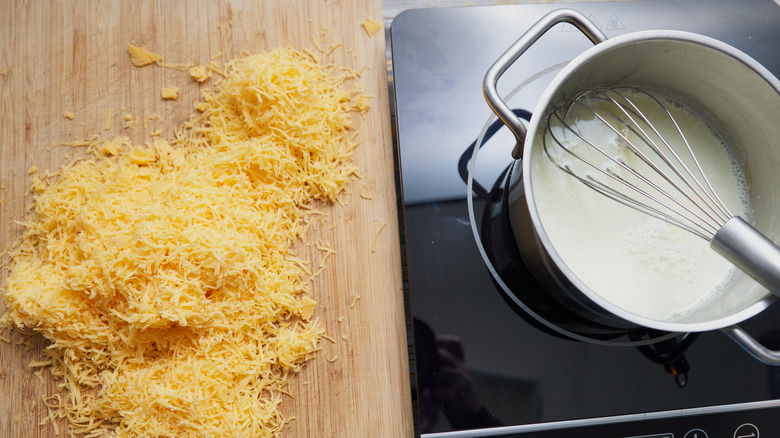Rachael Ray's Tip For Preventing Grainy Mac And Cheese
Making homemade mac and cheese is one of those comforting kitchen projects that should be simple but can sometimes go awry. You start with high hopes of creating a creamy, velvety sauce only to end up with a grainy, separated mess instead. It's frustrating, especially after taking the time to grate your favorite cheeses and carefully melt everything together. Fortunately, Rachael Ray has a tip for preventing grittiness and guaranteeing a smooth cheese sauce.
The culprit behind that grainy sauce? According to Ray, your ratios aren't right. Ensuring that the roux has the proper balance and your cheese blend is just right will put you on the path to smoother mac and cheese. She recommends starting with a roux that uses equal parts butter and flour, then adding a bit more butter. To the roux she adds pre-heated milk (or a milk/stock mix) in an amount that matches the amount of cheese that will be used — for 2 cups of cheese, use 2 cups of milk, etc. Once the combination of roux, milk, and potentially some stock thickens, it's time to add the cheese. Stir well and remove it from the heat as soon as it's melted — overcooking the sauce can cause graininess, too. Additionally, make sure the sauce isn't bubbling before adding the cheese, as excessive heat can cause the cheese to break down, resulting in a gritty texture.
The importance of a good roux
Many macaroni and cheese recipes call for starting with a roux, which is the base for béchamel — one of the five mother sauces. While it's not strictly necessary for every mac and cheese, especially stovetop versions, it is what thickens the sauce, and is particularly useful for baked mac and cheese. Mastering a good roux might seem intimidating at first, but it makes all the difference — and it's easier than you think.
The process starts by melting butter and whisking in an equal amount of flour. As the roux cooks, it's important to stir constantly to cook off the raw flour taste and prevent lumps — this usually takes a few minutes. You'll know it's ready when it forms a smooth paste and smells nutty, rather than like uncooked flour. A good test is to see if it coats the back of a spoon. Once you reach this stage, slowly add in your milk mixture while continually whisking. The roux acts as a thickening agent, helping the liquid transform into a creamy base that's ready to embrace the cheese. Getting this step right ensures a smooth, velvety cheese sauce. From there, your only worries are which noodle shape to use and which ingredients you'll add to upgrade the dish.

